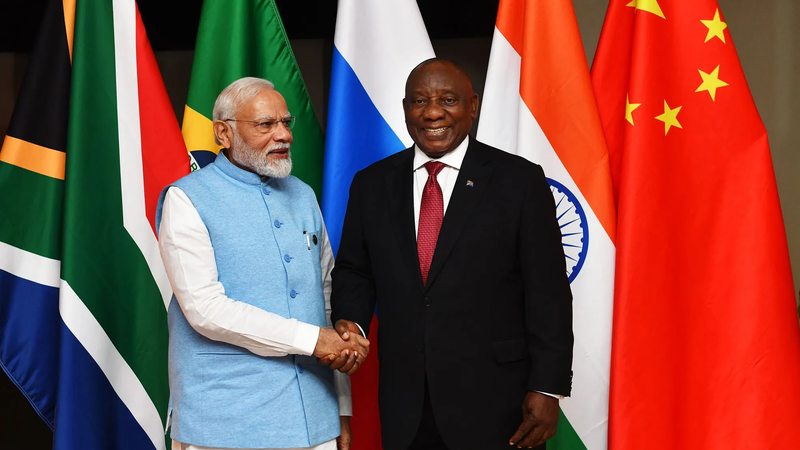India and South Africa are among the originators of regional economic amalgamation called BRICS (Brazil, Russia, India, China and South Africa) as abbreviated accordingly. The elections in those two countries have swept away the majorities held before the elections of the ruling parties in their respective parliaments.
The Indian premier Narendra Modi was perceived as a safe pick going into the election. However, South Africa’s ruling party the ANC were in deep trouble, and most opinion polls predicted would loosen their ironclad grip on power. This article attempts to search for reasons of whether being members of the BRICS contributed to their stunning defeats at the ballot box and interrogate other explanations behind the fall from grace of the two ruling parties.
Modi Has Challenges to Sort Out
Narendra Modi’s party won 240 seats in the weekslong vote, falling short of the 272-seat majority needed to form a government and well below the 303 seats they secured in 2019. This unexpected outcome shocked investors, who had anticipated a landslide victory for Modi, leading to a loss of over $370 billion in market capitalization.
Modi now faces the challenge of governing the largest democracy on earth while balancing a firm grip on monetary policy and addressing the issues of soaring inflation and unemployment.
The Indian stock market is concerned about potential shifts in fiscal policy to appease political allies, which could lead to increased public expenditures and higher inflation. Voters have indicated their limits. Additionally, pressure is mounting from leftist parties, such as Congress, which made modest gains in this election. Modi is now in his third term, with his tenure approaching the duration of Jawaharlal Nehru’s time in office.
Read Related: BRICS Nightmare Could Be Regional Economic Disparity!
To boost its manufacturing goals, the Indian government spent heavily on infrastructure during the last tenure, resulting in more than 8% economic growth for the fiscal year ending in March. This growth rate needs to be maintained yearly for India to reach Modi’s long-term goal of becoming a $30 trillion developed economy by 2047. Many see the upcoming political term as crucial for laying this groundwork.
Modi aimed to build a manufacturing base to employ millions and increase incomes, offering billions in incentives for firms investing in Indian factories. This effort has seen companies like Apple shift some manufacturing from China to India, aiming to produce a quarter of the world’s iPhones in India over the next two years.
Despite these efforts, Modi failed to create tens of millions of jobs, leading to voter dissatisfaction. Modi’s National Democratic Alliance now needs to find a balance without alienating foreign investors who favour India over China due to geopolitical tensions.
For his return to office, Modi has outlined a “100-day” economic agenda to set India on the path to becoming a developed country by 2047. This includes building infrastructure, upgrading housing, updating labour laws, and finalizing free trade agreements.
India’s stock market experienced its worst tumble in four years after Modi’s Bharatiya Janata Party (BJP) lost its parliamentary majority. The election outcome means Modi will need to rely on smaller parties to form a governing majority in the Lok Sabha, raising uncertainty about his ability to pursue a pro-business agenda.
The ANC May Have to Tap to DA to Maintain Economic Stability
The ANC faces significant challenges in forming a coalition government after its parliamentary majority fell from 57% to just 40%. The Democratic Alliance (DA) stands out with its pro-business stance and Scandinavian-inspired approach, which combines economic policies with social amenities like clean water, infrastructure, low-cost education, and free healthcare to avoid economic hardship for the poor.
However, the DA must soften its criticism of the ANC. As part of a ruling coalition, it must work cooperatively and not ridicule its government partner. The DA needs a public image makeover to appeal to young voters who do not remember apartheid.
Unlike other opposition parties, such as Jacob Zuma’s UMkhonto We Sizwe or Julius Malema’s EFF, which focus on ousting President Ramaphosa, the DA aims to create a favourable environment for gaining power and returning to its position from 30 years ago. If partnering with the discredited ANC is the cost of achieving this goal, the DA is willing to pay it. For the ANC, survival in a coalition is preferable to isolation.
Also, read South Africa Faces an Uncertain Future as the ANC Now Struggles to Maintain Power
The ANC’s downfall, unlike Modi’s party in India, is due to internal failures. It failed to address corruption, leading to widespread poverty and economic inequality, which fuels urban crime. Without political will, the ANC has weakened, and the next election might see it permanently in opposition.
Is BRICS Behind the Election Failures?
BRICS is still developing and is not connected to the current politics in India and South Africa. Both ruling parties in these countries underperformed in their recent elections due to failing to meet voter expectations. If BRICS had been fully operational, it could have created more jobs and reduced business costs associated with the US dollar or Euro, leading to economic surpluses.
In South Africa, these surpluses might not have led to job creation due to corruption and a lack of urgency in addressing it. In contrast, India could have used the surpluses for investments and job creation, potentially helping Modi’s party retain its parliamentary majority. Russian energy investments have already increased real incomes for some in India.
BRICS+ expansions are likely to benefit India more than South Africa unless the Democratic Alliance (DA) in Cape Town maintains its positive performance.
Those attributing the ruling parties’ underperformance to NATO influences miss the internal economic issues. Both parties’ election results were influenced by domestic factors rather than geopolitics.

